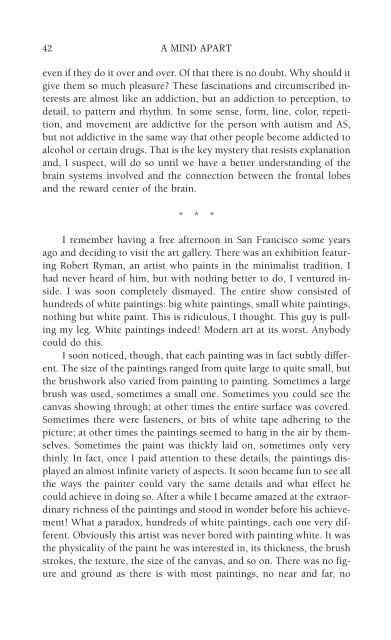978-1572305441
autism
autism
You also want an ePaper? Increase the reach of your titles
YUMPU automatically turns print PDFs into web optimized ePapers that Google loves.
42 A MIND APART<br />
even if they do it over and over. Of that there is no doubt. Why should it<br />
give them so much pleasure? These fascinations and circumscribed interests<br />
are almost like an addiction, but an addiction to perception, to<br />
detail, to pattern and rhythm. In some sense, form, line, color, repetition,<br />
and movement are addictive for the person with autism and AS,<br />
but not addictive in the same way that other people become addicted to<br />
alcohol or certain drugs. That is the key mystery that resists explanation<br />
and, I suspect, will do so until we have a better understanding of the<br />
brain systems involved and the connection between the frontal lobes<br />
and the reward center of the brain.<br />
* * *<br />
I remember having a free afternoon in San Francisco some years<br />
ago and deciding to visit the art gallery. There was an exhibition featuring<br />
Robert Ryman, an artist who paints in the minimalist tradition. I<br />
had never heard of him, but with nothing better to do, I ventured inside.<br />
I was soon completely dismayed. The entire show consisted of<br />
hundreds of white paintings: big white paintings, small white paintings,<br />
nothing but white paint. This is ridiculous, I thought. This guy is pulling<br />
my leg. White paintings indeed! Modern art at its worst. Anybody<br />
could do this.<br />
I soon noticed, though, that each painting was in fact subtly different.<br />
The size of the paintings ranged from quite large to quite small, but<br />
the brushwork also varied from painting to painting. Sometimes a large<br />
brush was used, sometimes a small one. Sometimes you could see the<br />
canvas showing through; at other times the entire surface was covered.<br />
Sometimes there were fasteners, or bits of white tape adhering to the<br />
picture; at other times the paintings seemed to hang in the air by themselves.<br />
Sometimes the paint was thickly laid on, sometimes only very<br />
thinly. In fact, once I paid attention to these details, the paintings displayed<br />
an almost infinite variety of aspects. It soon became fun to see all<br />
the ways the painter could vary the same details and what effect he<br />
could achieve in doing so. After a while I became amazed at the extraordinary<br />
richness of the paintings and stood in wonder before his achievement!<br />
What a paradox, hundreds of white paintings, each one very different.<br />
Obviously this artist was never bored with painting white. It was<br />
the physicality of the paint he was interested in, its thickness, the brush<br />
strokes, the texture, the size of the canvas, and so on. There was no figure<br />
and ground as there is with most paintings, no near and far, no



